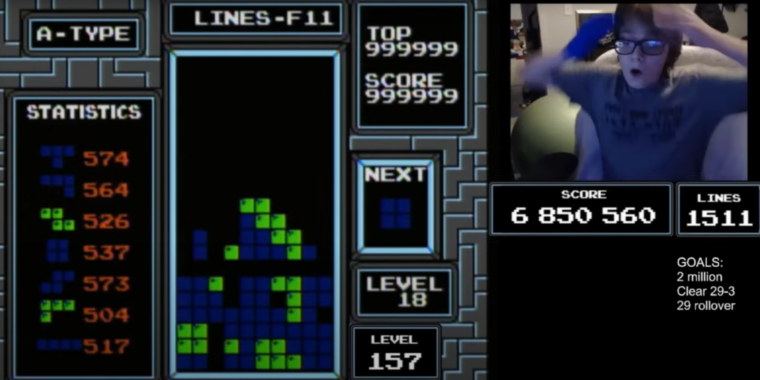34 years later, a 13-year-old hits the NES Tetris “kill screen”
For decades after its 1989 release, each of the hundreds of millions of standard NES Tetris games ended the same way: A block reaches the top of the screen and triggers a “game over” message. That 34-year streak was finally broken on December 21, 2023, when 13-year-old phenom BlueScuti became the first human to reach the game’s “kill screen” after a 40-minute, 1,511-line performance, crashing the game by reaching its functional limits.
The game-crashing, record-setting performance. Jump to 38: 56 for BlueScuti’s disbelieving reaction to his achievement and a short interview.
What makes BlueScuti’s achievement even more incredible (as noted in some excellent YouTube summaries of the scene) is that, until just a few years ago, the Tetris community at large assumed it was functionally impossible for a human to get much past 290 lines. The road to the first NES Tetris kill screen highlights the surprisingly robust competitive scene that still surrounds the classic game and just how much that competitive community has been able to collectively improve in a relatively short time.
From hypertaps to rolling
If and when a player reaches Level 29 on NES Tetris (after clearing between 230 to 290 lines, depending on the starting level), the game reaches its highest possible speed. At this point, simply holding down left or right on the NES D-pad can’t usually get a piece all the way to the side of the well unless the board is extremely “low” (i.e., pieces only on the first one or two rows, maximum). Thus, for years, players that reached Level 29 found their games usually “topped out” just a few pieces later.
A demonstration of hypertapping technique.
The first known way past the brick wall of Level 29 was a technique that became known as hypertapping. By using a special grip that lets you vibrate a finger over the D-pad directions at least 10 times a second, you can effectively skip the “delayed autoshift” (DAS) that limits how fast pieces can move laterally when the D-pad is held down.
With hypertapping, players can effectively move pieces at Level 29 speed even when the board is stacked four or five levels high. While that gives a little breathing room, a run of bad pieces or execution can still put a hypertapper in an untenable position where the pieces start to stack up high, and completing new lines becomes essentially impossible.
The first Level 30 NES Tetris performance on record, from back in 2011.
Noted Tetris pro Thor Aackerlund was able to eke out a Level 30 hypertapping performance in 2011. But it wouldn’t be until 2018 that Joseph Saelee used his mastery of the technique to dominate the 2018 and 2019 editions of the Classic Tetris World Championship, a live tournament that takes place at the Portland Retro Gaming Expo every year. By 2020, Saelee had hypertapped his way to a Level 35 performance, while fellow player EricICX had achieved the first Level 38 performance.
A deep dive into the advanced Tetris control technique known as rolling.
Then, in 2021, a new, even faster button-mashing technique appeared on the competitive Tetris scene. This “rolling” technique was inspired by arcade player Hector “Fly” Rodriguez, who used a similar multi-finger roll to set button-mashing records on the Track & Field arcade game. Tetris players adapted this technique by combining it with a grip that lets you tap the back of the NES controller with a “roll” of three to five successive fingers. This roll of the fingers then nudges the D-pad into a finger on the other hand to register an extremely quick series of directional button presses.
Rolling is fast enough to get pieces to the sides on Level 29-speed boards stacked up to eight rows high, giving Tetris masters quite a bit of leeway in their quest for longer games. Cheez, one of the first players to master the rolling technique, hit Level 40 in 2021, but that was just the start of how far things could go.
A Level 146 performance from 2022 that shows NES Tetris can be effectively played indefinitely at Level 29 speed.
By the time EricICX managed to roll his way to Level 146 in August 2022, it was clear that players were getting good enough to effectively play indefinitely on the same “Level 29” speed that had been considered an effective kill screen just a few years earlier. Players were getting so good at stretching their NES Tetris games that the community started debating how to stop tournament matches from going on too long (they eventually settled on a modded game with an even faster Level 39 “super killscreen” for competitive play).
34 years later, a 13-year-old hits the NES Tetris “kill screen” Read More »
